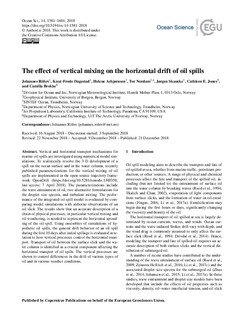| dc.contributor.author | Röhrs, Johannes | |
| dc.contributor.author | Dagestad, Knut-Frode | |
| dc.contributor.author | Asbjørnsen, Helene | |
| dc.contributor.author | Nordam, Tor | |
| dc.contributor.author | Skancke, Jørgen | |
| dc.contributor.author | Jones, Cathleen | |
| dc.contributor.author | Brekke, Camilla | |
| dc.date.accessioned | 2018-12-30T15:30:52Z | |
| dc.date.available | 2018-12-30T15:30:52Z | |
| dc.date.created | 2018-12-17T09:02:55Z | |
| dc.date.issued | 2018-12-21 | |
| dc.identifier.citation | Ocean Science. 2018, 14 1581-1601. | nb_NO |
| dc.identifier.issn | 1812-0784 | |
| dc.identifier.uri | http://hdl.handle.net/11250/2578717 | |
| dc.description.abstract | Vertical and horizontal transport mechanisms for marine oil spills are investigated using numerical model simulations. To realistically resolve the 3-D development of a spill on the ocean surface and in the water column, recently published parameterizations for the vertical mixing of oil spills are implemented in the open-source trajectory framework OpenDrift (https://doi.org/10.5281/zenodo.1300358, last access: 7 April 2018). The parameterizations include the wave entrainment of oil, two alternative formulations for the droplet size spectra, and turbulent mixing. The performance of the integrated oil spill model is evaluated by comparing model simulations with airborne observations of an oil slick. The results show that an accurate description of a chain of physical processes, in particular vertical mixing and oil weathering, is needed to represent the horizontal spreading of the oil spill. Using ensembles of simulations of hypothetic oil spills, the general drift behavior of an oil spill during the first 10 days after initial spillage is evaluated in relation to how vertical processes control the horizontal transport. Transport of oil between the surface slick and the water column is identified as a crucial component affecting the horizontal transport of oil spills. The vertical processes are shown to control differences in the drift of various types of oil and in various weather conditions. | nb_NO |
| dc.description.sponsorship | This work has been funded by the Research Council of Norway through grants 244626 (RETROSPECT) and 237906 (CIRFA) and in part by a grant from The Gulf of Mexico Research Initiative (“Influence of river-induced fronts on hydrocarbon transport”, GOMA 23160700). This research was carried out in part at the Jet Propulsion Laboratory, California Institute of Technology, under contract with the National Aeronautics and Space Administration. The UAVSAR data are courtesy of NASA/JPL-Caltech and are available through http://uavsar.jpl.nasa.gov (last access: 19 December 2018) or the Alaska Satellite Facility (http://www.asf.alaska.edu, last access: 19 December 2018). We would also like to acknowledge the very constructive feedback from two reviewers that helped to improve this paper. | nb_NO |
| dc.language.iso | eng | nb_NO |
| dc.publisher | Copernicus publications | nb_NO |
| dc.rights | Navngivelse 4.0 Internasjonal | * |
| dc.rights.uri | http://creativecommons.org/licenses/by/4.0/deed.no | * |
| dc.title | The effect of vertical mixing on the horizontal drift of oil spills | nb_NO |
| dc.type | Journal article | nb_NO |
| dc.type | Peer reviewed | nb_NO |
| dc.description.version | publishedVersion | nb_NO |
| dc.rights.holder | © Author(s) 2018. This work is distributed under the Creative Commons Attribution 4.0 License. | nb_NO |
| dc.source.pagenumber | 1581-1601 | nb_NO |
| dc.source.volume | 14 | nb_NO |
| dc.source.journal | Ocean Science | nb_NO |
| dc.identifier.doi | 10.5194/os-14-1581-2018 | |
| dc.identifier.cristin | 1643810 | |
| dc.relation.project | Norges forskningsråd: 244626 | nb_NO |
| dc.relation.project | Norges forskningsråd: 237906 | nb_NO |
| cristin.unitcode | 7566,6,0,0 | |
| cristin.unitname | Miljø og nye ressurser | |
| cristin.ispublished | true | |
| cristin.fulltext | original | |
| cristin.qualitycode | 1 | |

